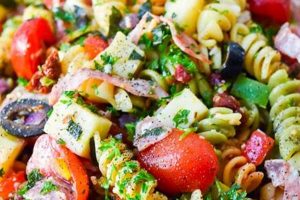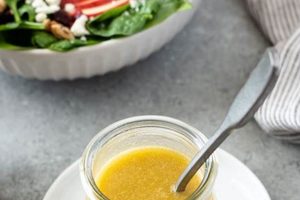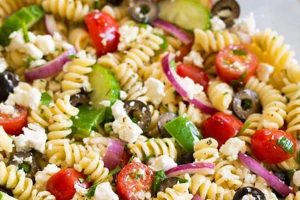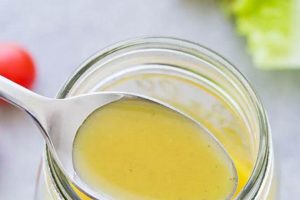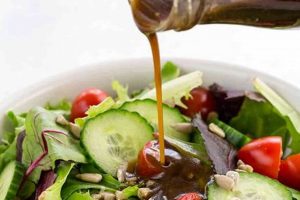The essential blend of flavors for this vibrant Thai salad typically includes ingredients such as fish sauce, lime juice, palm sugar, garlic, chilies, and often dried shrimp or tamarind pulp. Variations exist to accommodate different taste preferences, ranging from milder versions to those with intense heat. A properly balanced dressing is key to achieving the characteristic sweet, sour, salty, spicy, and umami notes that define the dish.
This mixture delivers a powerful punch of flavor that elevates shredded green papaya and other vegetables into a truly memorable culinary experience. Historically, the dressing reflects the agricultural bounty of Southeast Asia, utilizing readily available ingredients. Its evolution mirrors the development of Thai cuisine, adapting to regional preferences and incorporating new influences over time. A well-executed dressing creates the foundation for a dish that embodies the principles of balance and freshness central to Thai gastronomy.
The subsequent sections will delve deeper into the specific components, preparation methods, and variations, providing a comprehensive guide to crafting an authentic and delicious accompaniment to green papaya salad.
Tips for Crafting the Perfect Som Tum Dressing
Achieving the perfect balance of flavors is essential for a truly authentic experience. These tips offer guidance on ingredient selection and preparation techniques to elevate one’s culinary creation.
Tip 1: Fresh Lime Juice is Key: Bottled lime juice often lacks the vibrant acidity of freshly squeezed limes. Always opt for fresh limes for the brightest, most authentic flavor profile.
Tip 2: Balance is Paramount: Taste and adjust the dressing throughout the preparation process. The goal is a harmonious blend of sweet, sour, salty, and spicy. No single element should overpower the others.
Tip 3: The Right Chili Matters: Thai chilies offer a unique heat and flavor. Bird’s eye chilies are traditional, but the amount can be adjusted based on spice preference. Consider using a mortar and pestle for a more nuanced flavor release.
Tip 4: Palm Sugar Preference: While granulated sugar can be substituted, palm sugar provides a more complex sweetness and a rich caramel note that enhances the overall depth of the dressing.
Tip 5: Fish Sauce Quality: Fish sauce quality significantly impacts the final result. Opt for a high-quality fish sauce with a balanced flavor profile.
Tip 6: Garlic and Shrimp Considerations: Pounding the garlic lightly releases its aromatic oils. Dried shrimp, when included, contribute a savory umami element. Toasting them briefly before adding them enhances their flavor.
Tip 7: Gradual Incorporation: Start with the garlic and chilies, then gradually add the remaining liquid ingredients. This allows for better flavor integration and adjustment.
By following these guidelines, one can achieve a dressing that captures the essence of Thai culinary tradition, resulting in a vibrant and flavorful culinary experience. These foundations pave the way for a dish that delivers on authenticity and taste.
The following section will provide further detail on variations and serving suggestions to enhance your understanding and enjoyment of this classic Thai preparation.
1. Authentic Flavor Profile
An authentic flavor profile is paramount to a successful som tum salad dressing. It represents the delicate balance of sweet, sour, salty, spicy, and umami notes characteristic of Thai cuisine. Achieving this balance requires careful consideration of ingredient selection and preparation.
- The Role of Fish Sauce:
Fish sauce provides the foundational saltiness and umami depth. Quality variations exist; those with a balanced, not overly pungent, aroma contribute most authentically. The fermentation process and ingredients used in fish sauce production significantly influence the final flavor profile of the dressing. Its role extends beyond mere saltiness, adding complexity and depth.
- Lime Juice’s Balancing Act:
Freshly squeezed lime juice delivers the essential sour element, balancing the saltiness of the fish sauce and the sweetness of palm sugar. Its bright acidity also helps to “lift” the other flavors, preventing the dressing from becoming heavy or cloying. Using bottled lime juice often results in a flat, less vibrant taste.
- Palm Sugar’s Subtle Sweetness:
Palm sugar, derived from the sap of various palm trees, offers a unique sweetness distinct from granulated sugar. Its complex caramel notes contribute to the overall depth and richness of the dressing. The slight earthiness of palm sugar complements the other ingredients, creating a more nuanced flavor profile.
- The Heat of Chilies:
Thai chilies, specifically bird’s eye chilies, provide the characteristic heat. The level of spiciness can be adjusted to preference. The type of chili used also impacts the flavor; some varieties offer fruity or smoky notes in addition to heat. The preparation method, such as pounding the chilies, further influences the flavor release and intensity.
These elements combine to create a flavor profile that is both vibrant and balanced. Each ingredient plays a crucial role, contributing to the overall sensory experience. Deviation from traditional ingredients or preparation techniques can compromise the authenticity and complexity of the final dressing, impacting the overall enjoyment of the som tum salad.
2. Ingredient Quality
Ingredient quality significantly impacts the final flavor profile of som tum salad dressing. The nuanced interplay of sweet, sour, salty, spicy, and umami relies on the freshness and quality of each component. Subpar ingredients can result in a muted or unbalanced dressing, diminishing the overall culinary experience. For instance, using fish sauce made with substandard ingredients or improper fermentation techniques can introduce off-flavors, overpowering the delicate balance of the dressing. Similarly, stale chilies lack the vibrant heat and nuanced flavor of fresh ones, resulting in a less dynamic sensory experience.
Freshly squeezed lime juice offers a brightness and acidity unmatched by bottled alternatives, which often contain preservatives and additives that can negatively affect the flavor. The use of palm sugar, with its complex caramel notes, contributes significantly to the overall depth of flavor compared to using refined white sugar. Sourcing high-quality dried shrimp, when used, introduces a rich umami element that enhances the complexity of the dressing. Even the quality of garlic can influence the final result; fresh, firm cloves offer a more pungent and desirable flavor compared to older, sprouted cloves.
Prioritizing ingredient quality ensures the creation of a dressing that truly captures the essence of Thai culinary tradition. The interplay of high-quality ingredients allows the individual flavors to shine while harmonizing to create a balanced and vibrant whole. While substitutions may be necessary at times, understanding the impact of ingredient quality empowers informed choices that maintain the integrity of this classic Thai preparation. Investing in quality ingredients elevates the dish from simply palatable to a truly authentic and memorable culinary experience. This dedication to quality underscores a respect for the culinary tradition and ensures a more satisfying end result.
3. Precise Measurements
Precision in measurement is crucial for achieving the delicate balance of flavors that defines a successful som tum salad dressing. While culinary intuition plays a role, especially with experience, a foundational understanding of the interplay between ingredients requires adherence to measured quantities. This ensures consistency and allows for adjustments based on personal preference without compromising the essential flavor profile.
- Fish Sauce Quantity:
Fish sauce contributes saltiness and umami. Too much can overpower the other flavors, while too little results in a bland dressing. Precise measurement ensures the fish sauce enhances the other ingredients without dominating the flavor profile. A typical recipe might call for one to two tablespoons, but adjustments may be necessary based on the specific fish sauce used, as saltiness can vary between brands.
- Lime Juice Acidity:
Lime juice provides the essential sour element. The correct amount balances the other flavors, particularly the sweetness of the palm sugar and the saltiness of the fish sauce. An excess of lime juice can make the dressing overly tart, whereas insufficient lime juice results in a flat, less vibrant flavor. Two to three tablespoons is a common starting point, with adjustments made according to the size and juiciness of the limes.
- Palm Sugar Sweetness:
Palm sugar adds a unique sweetness. Accurate measurement prevents the dressing from becoming cloyingly sweet or lacking the necessary balance. The desired level of sweetness can vary based on individual preference, but typically one to two tablespoons of palm sugar is used. It is important to note that palm sugar can be denser than granulated sugar, so adjustments may be required when substituting.
- Chili Heat Level:
The amount of chili used directly determines the spiciness of the dressing. Precise measurement is crucial for controlling the heat level according to individual preference. One or two chilies is a common starting point for a mild heat level, with additional chilies added for increased spiciness. It’s important to consider the type of chili used, as some varieties are significantly hotter than others.
Precise measurements in a som tum salad dressing recipe ensure the final dish achieves the intended balance of flavors. While adjustments can and should be made to cater to personal preferences, a foundation of accurate measurements ensures consistency and allows for informed adjustments. This precision emphasizes the importance of each ingredient’s contribution to the final product and highlights the careful orchestration of flavors essential to authentic Thai cuisine.
4. Balance of Tastes
The “balance of tastes” represents a core principle within Thai culinary tradition, particularly evident in som tum salad dressing. This balance refers to the harmonious interplay of sweet, sour, salty, spicy, and umami elements. Each taste component plays a distinct role, contributing to the overall sensory experience. The sweetness, typically derived from palm sugar, tempers the spiciness of chilies and provides a foundational layer of flavor. Sourness, from lime juice, brightens the palate and cuts through the richness of other ingredients. Saltiness, imparted by fish sauce, provides a savory depth and enhances the other taste dimensions. Spiciness, derived from chilies, adds a stimulating heat that varies based on personal preference. Umami, often contributed by fish sauce or dried shrimp, adds a savory depth and rounds out the flavor profile. Disrupting this balance, such as by overemphasizing one flavor component, compromises the integrity of the dish and diminishes its authenticity.
Consider a som tum dressing where the fish sauce dominates. The excessive saltiness would mask the subtle sweetness of the palm sugar and the bright acidity of the lime juice, creating a one-dimensional and less nuanced flavor profile. Alternatively, if the chilies are overwhelming, the intense heat would overshadow the other taste dimensions, rendering the dish unbalanced and potentially unpalatable to some. Conversely, a well-balanced dressing allows each flavor to shine while harmonizing with the others. The sweetness complements the spiciness, the sourness balances the saltiness, and the umami underpins the overall flavor profile, creating a complex and satisfying sensory experience. This principle exemplifies the Thai culinary philosophy of incorporating contrasting yet complementary flavors.
Achieving this balance requires careful consideration of ingredient quality and precise measurements. High-quality fish sauce provides a clean saltiness and umami depth, while fresh lime juice offers vibrant acidity crucial for balancing the other components. Accurate measurement ensures that no single flavor dominates the others, preserving the intended harmony. Understanding this interplay of tastes is fundamental to appreciating and replicating authentic Thai flavors. Mastering this balance allows for informed adjustments based on personal preference without compromising the essential flavor profile that defines som tum salad dressing. This principle extends beyond som tum, informing the broader landscape of Thai cuisine and highlighting the significance of balanced flavors in culinary traditions worldwide.
5. Fresh Ingredients
Fresh ingredients are paramount to an authentic and flavorful som tum salad dressing. The vibrancy and complexity of this classic Thai preparation rely on the quality and freshness of its components. Utilizing fresh ingredients not only enhances the flavor profile but also contributes to the overall textural experience and nutritional value of the dish. The following facets explore the critical role of freshness in creating a truly exceptional som tum dressing.
- Lime Juice Vibrancy
Freshly squeezed lime juice provides a brightness and acidity unmatched by bottled alternatives. The volatile aromatic compounds present in fresh limes dissipate over time, resulting in a diminished flavor profile in bottled juice. Furthermore, bottled lime juice often contains preservatives and additives that can negatively impact the delicate balance of the som tum dressing. Freshly squeezed lime juice contributes a vibrant, zesty acidity crucial for balancing the other flavor components, ensuring a more authentic and flavorful outcome.
- Garlic and Chili Potency
Fresh garlic and chilies possess a pungency and depth of flavor that diminishes with age. The aromatic compounds responsible for their characteristic flavors degrade over time, resulting in a less potent and nuanced taste. Fresh garlic, when pounded or minced, releases its full aromatic potential, contributing a sharp, savory note to the dressing. Similarly, fresh chilies offer a vibrant heat and complex flavor profile, crucial for achieving the desired level of spiciness in the som tum salad. Using fresh ingredients ensures that these key flavor components are at their peak potency, maximizing their impact on the overall sensory experience.
- Green Papaya Texture and Flavor
While not a component of the dressing itself, the freshness of the green papaya is intrinsically linked to the success of the dish. Fresh green papaya offers a crisp, firm texture and a subtly sweet, slightly peppery flavor that complements the vibrant dressing. As green papaya ages, its texture becomes softer and its flavor less pronounced, diminishing the overall culinary experience. The freshness of the green papaya is essential for achieving the desired textural contrast and ensuring that the flavors of the dressing and the papaya harmonize effectively.
- Herb and Vegetable Crispness
Additional fresh ingredients, such as tomatoes, long beans, and Thai basil, are often incorporated into som tum salad. The freshness of these components contributes to the overall textural complexity and provides additional layers of flavor. Crisp, fresh vegetables offer a satisfying crunch that contrasts with the softer texture of the green papaya, while fresh herbs provide bright, aromatic notes that enhance the overall sensory experience. Using wilted or less-than-fresh vegetables and herbs compromises the textural integrity and flavor profile of the salad, diminishing its appeal.
The emphasis on fresh ingredients in som tum salad dressing highlights the importance of quality and seasonality in Thai cuisine. By prioritizing fresh components, the dish achieves a vibrancy and depth of flavor impossible to replicate with substitutes or processed ingredients. This dedication to freshness underscores a respect for the culinary tradition and ensures a more authentic and satisfying culinary experience. The interplay of fresh ingredients elevates the som tum salad from a simple combination of components to a vibrant expression of Thai culinary artistry.
6. Proper Technique
Proper technique is essential for creating an authentic and flavorful som tum salad dressing. Beyond ingredient quality, the methods employed to prepare and combine the components significantly influence the final outcome. These techniques, honed over generations, maximize the flavor potential of each ingredient and contribute to the characteristic texture and balance of the dressing. From the rhythmic pounding of the mortar and pestle to the order in which ingredients are incorporated, each step plays a crucial role in achieving the desired result.
- The Art of Pounding:
Traditional som tum utilizes a mortar and pestle to bruise and combine the ingredients. This process gently releases the flavors of the garlic and chilies, creating a more nuanced and complex flavor profile than simply mincing or chopping. The pounding action also helps to meld the flavors together, creating a more cohesive dressing. The rhythmic pounding is a hallmark of traditional Thai cooking, representing a connection to culinary heritage.
- Order of Incorporation:
The sequence in which ingredients are added to the mortar affects the final flavor profile. Traditionally, garlic and chilies are pounded first, releasing their aromatic compounds. Palm sugar is then added and dissolved, followed by the remaining liquid ingredients. This gradual incorporation allows each ingredient to meld with the others, creating a more harmonious blend of flavors. Adding all the ingredients simultaneously can result in an uneven distribution of flavors and a less cohesive dressing.
- Balancing Flavors:
Proper technique involves continuous tasting and adjusting throughout the preparation process. The balance of sweet, sour, salty, and spicy is paramount, and achieving this requires ongoing assessment and modification. This iterative process allows for personalized adjustments based on individual preferences and the specific ingredients used. It also reinforces the importance of understanding the interplay of flavors and how each component contributes to the overall balance of the dressing.
- Resting and Marinating (Optional):
While not always practiced, allowing the dressing to rest for a short period after preparation can enhance flavor development. This allows the flavors to meld and deepen, creating a more complex profile. This step is particularly beneficial when incorporating dried shrimp or other ingredients that benefit from a brief period of marination.
These techniques, though seemingly simple, demonstrate a deep understanding of flavor dynamics and the importance of precise execution in Thai cuisine. Mastery of these techniques elevates the som tum salad dressing beyond a mere combination of ingredients, transforming it into a nuanced and flavorful representation of Thai culinary artistry. By adhering to these traditional methods, one ensures the creation of a dressing that is both authentic and delicious, capturing the essence of Thai culinary heritage.
7. Adaptability
Adaptability is a hallmark of som tum salad dressing recipes, reflecting both regional variations and individual preferences. While core elements remain consistent, the recipe demonstrates remarkable flexibility in accommodating ingredient availability, spice tolerance, and dietary restrictions. This inherent adaptability ensures the recipe’s continued relevance across diverse culinary landscapes and allows for personalized interpretations without compromising the essence of the dish.
- Regional Variations:
Som tum recipes vary significantly across Thailand and Southeast Asia. In some regions, dried shrimp or fermented fish paste (pla ra) are prominent ingredients, contributing a pungent umami dimension. Other variations incorporate ingredients like tamarind pulp, contributing a tangy complexity. These regional adaptations reflect local ingredient availability and culinary traditions, demonstrating the recipe’s capacity to evolve while retaining its core identity. For instance, a northeastern Thai (Isan) version might emphasize the use of pa daek (fermented fish sauce), while a Lao version might include shredded carrots or green beans.
- Spice Level Adjustments:
The spiciness of som tum is readily adaptable. The number of chilies incorporated into the dressing can be adjusted to accommodate individual preferences, ranging from mild to intensely fiery. This flexibility ensures the dish remains accessible to a wider range of palates. Some variations even utilize milder chili types or omit them altogether, catering to those sensitive to heat. This adaptability highlights the personalized nature of som tum preparation.
- Dietary Accommodations:
Som tum can be adapted to accommodate various dietary restrictions. Vegan versions often omit dried shrimp or fish sauce, substituting soy sauce or seaweed for umami. Sugar substitutes can be used to cater to those with specific dietary needs. These adaptations demonstrate the recipe’s versatility and inclusivity, making it accessible to a broader audience. For example, using maple syrup or agave nectar in place of palm sugar allows individuals avoiding refined sugars to enjoy the dish.
- Ingredient Substitutions:
While certain ingredients are considered essential to an authentic som tum dressing, some substitutions are permissible based on availability. For instance, if palm sugar is unavailable, brown sugar or even granulated sugar can be used, although the flavor profile will be subtly different. Similarly, lime juice can be substituted with other citrus juices like lemon or grapefruit in situations where limes are scarce. While purists may advocate for specific ingredients, these substitutions highlight the recipe’s practicality and resilience in diverse culinary contexts.
The adaptability of som tum salad dressing underscores its enduring popularity and its capacity to transcend regional and cultural boundaries. This flexibility allows the recipe to be personalized, reflecting individual tastes and ingredient availability without sacrificing its fundamental character. This adaptability ensures that som tum remains a vibrant and evolving culinary tradition, capable of satisfying a diverse range of palates and culinary contexts.
Frequently Asked Questions
This section addresses common inquiries regarding the preparation and nuances of som tum salad dressing.
Question 1: What makes an authentic som tum salad dressing?
Authenticity hinges on the balance of sweet, sour, salty, spicy, and umami flavors. This balance is achieved through the precise combination of fresh ingredients, typically including fish sauce, lime juice, palm sugar, garlic, and chilies. Regional variations may incorporate additional ingredients like dried shrimp, tamarind pulp, or fermented fish paste (pla ra).
Question 2: Can granulated sugar be substituted for palm sugar?
While granulated sugar can be used as a substitute, palm sugar contributes a distinct complex sweetness and subtle caramel notes that enhance the overall depth of flavor. Granulated sugar will yield a different, less nuanced sweetness.
Question 3: How can the spiciness of the dressing be adjusted?
Spice levels are easily adjusted by varying the number of chilies used. For a milder dressing, fewer chilies, or milder varieties, can be incorporated. Alternatively, removing the chili seeds and membranes before pounding reduces the heat intensity.
Question 4: Is it essential to use a mortar and pestle?
While a mortar and pestle is traditional and recommended for optimal flavor release and texture, alternative methods like finely mincing or using a food processor can be employed. However, the nuanced flavor development achieved through pounding may be less pronounced.
Question 5: What are common variations in som tum salad dressing recipes?
Regional variations abound, reflecting local ingredient availability and culinary traditions. Some versions incorporate dried shrimp or fermented fish paste for added umami, while others utilize tamarind pulp for a tangy complexity. The addition of ingredients like tomatoes, long beans, or peanuts also contributes to regional variations.
Question 6: How can the dressing be adapted for dietary restrictions?
Som tum dressing can be adapted for various dietary needs. Vegan versions may omit fish sauce and dried shrimp, substituting soy sauce or seaweed for umami. Sugar substitutes can be used to accommodate specific dietary restrictions. It is important to note that these adaptations may subtly alter the traditional flavor profile.
Understanding these frequently asked questions facilitates a deeper understanding of som tum salad dressing preparation and its nuanced variations. Proper technique, ingredient quality, and precise measurements contribute significantly to the authentic flavor profile of this iconic Thai dish.
For further exploration, the following sections delve into specific recipe variations and offer detailed instructions for preparing som tum salad dressing at home.
Som Tum Salad Dressing Recipe
Exploration of the essential components of a som tum salad dressing recipe reveals the intricate interplay of flavors that define this iconic Thai dish. Freshness of ingredients, precise measurements, and proper techniques are paramount to achieving the characteristic balance of sweet, sour, salty, spicy, and umami notes. Ingredient quality significantly influences the final flavor profile, emphasizing the importance of selecting high-quality fish sauce, lime juice, palm sugar, garlic, and chilies. The adaptability of the recipe allows for regional variations and personalized adjustments while preserving the fundamental essence of the dish.
Mastery of a som tum salad dressing recipe offers a gateway to exploring the rich tapestry of Thai culinary tradition. This seemingly simple preparation embodies a complex interplay of flavors and techniques, reflecting a deep understanding of culinary principles. Continued exploration and experimentation with various ingredients and techniques will further enhance appreciation for the nuanced artistry of Thai cuisine and its vibrant culinary heritage.

